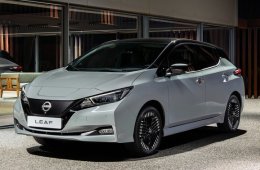|
|
VS |
|
This is the GWM Ora Vs Nissan Leaf comparison for 2024. Essentially this is a comparison of one of the oldest and arguably the original mass market electric car compared to one of the newest but cheapest electric car you can currently purchase on the Australian market. So how does the oldest electric car brands in the Nissan Leaf compare against the newest and cheapest represented by the GWM Ora.
GWM Ora Vs Nissan Leaf exterior comparison: The Leaf is clearly the older model based on exterior lines. There is nothing fancy about the design of the Leaf. Only its odd alloy wheel design and two tone body colour sets it apart from being any other older hatch model. In comparison the Ora is overall quite a conservative looking car as well. However it’s newer curves and proportions are impressively contemporary but admittedly clone like. We do prefer the look of the Ora.
GWM Ora Vs Nissan Leaf interior comparison: The Leaf interior looks quite aged to be honest but it does have decent quality of materials. In comparison the GWM Ora interior is a couple levels above the Leaf, it is modern and an easily upmarket interior to be in. We definitely prefer to be in the Ora.
GWM Ora Vs Nissan Leaf engine and technology comparison: Both are essentially the same tech package underneath made by different manufacturers. The Leaf has the more refined one pedal driving and is as good as the Tesla implementation.
The conclusion and winner of the GWM Ora Vs Nissan Leaf comparison is the GWM Ora. Let’s face it the GWM Ora is the update that the Nissan Leaf should have had. And without the Leaf as the template the Ora would not have existed. If you want a pure electric car for a decent price buy the GWM Ora. However the main condition of the comparison win is that: as long as it’s priced (at the time of the post) at 36K on the road for the entry level model.
| Nissan Leaf | GWM / Haval Ora |
 |
 |
| Engines | |
| Single Motor FWD Standard Range Power 110 Kw Torque 320 Nm Long Range Power 160 Kw Torque 340 Nm |
Single Motor FWD 1 – 126 Kw and 250 |
| Weight | |
| From Approx Kerb weight 1594 kg Towing capacity up to xxxx kg |
From Approx Kerb weight 1580 kg Towing capacity up to xxxx kg |
| Fuel capacity & consumption | |
| Single motor Battery size 39 kWh Claimed range 270 Km (WLTP) Battery size 59 kWh Claimed range 385 Km (WLTP) |
Single motor 1 – Battery size 48 kWh Claimed range 310 Km (WLTP) 2 – Battery size 63 kWh Claimed range 420 Km (WLTP) |
| Other specifications | |
| 1 Speed Overall height/width 1545/1788 Overall length/wheelbase 4490/2700 4WD system: FWD ANCAP Safety: 5/5 |
1 Speed Overall height/width 1603/1825 Overall length/wheelbase 4235/2650 4WD system: FWD ANCAP Safety: ?/5 |
| Capability | |
| Angle of: (degrees) Approach xx Departure xx Breakover xx Ground clearance (unloaded) xxx mm Water Fording depth xxmm Max |
Angle of: (degrees) Approach xx Departure xx Breakover xx Ground clearance (unloaded) xxx mm Water Fording depth xxmm Max |
| Performance | |
| Single electric motor 0-100kph 7.9 Secs Long Range 0-100kph 6.9 Secs |
Single electric motor 0-100kph 8.5 Secs |
| Pricing | |
| 2024 $50,990 – 61,490 AUD | 2024 $35,990 – 46,990 AUD 2023 $39,990 – 59,990 AUD |
| *Specs change due to model grade and configuration. Always check with the dealer for up to date pricing, specifications, on-road costs, accessories and specials etc.. everything as usual is subject to change! | |





